|
Common names:
China |
Chinese Mandarin |
马六甲弹涂鱼, 馬六甲彈塗魚 (Ma liu jia tan tu yu - Malacca mudskipper) |
Italy |
Italian |
perioftalmo della Malacca* |
Philippines |
Tagalog |
Bia |
* proposed name
|
|
Synonyms:
|
Periophthalmus malaccensis |
Eggert, 1935 |
(senior syn., original combination) |
Etymology:
'Periophthalmus' is a compound name from the Greek 'peri' (around), and 'ophthalmôn' (eye), which refers to the wide
visual field of these species
'malaccensis' is an adjective from 'Malacca', which refers to the Straits of Malacca, where is the type locality
(Singapore: Murdy, 1989) |
Maximum recorded length:
100 mm SL (Eggert, 1935)
Live colouration
(photos: pers. obs.: North Sulawesi):
background colour brownish, ventrally paler, but dark below head and on isthmus in several specimens;
numerous tiny sky blue speckles on cheeks, opercula, and throat; sparse bluish iridescent speckles
on flanks; irregular mottled pattern of dark brown blotches along flanks; 4-8 dorsal dark brown saddle-like
diagonal bars often visible; D1 proximally brownish-red with numerous white spots in the middle and posterior
portion (lacking or only present basally in some specimens), a dark brown inframarginal stripe sandwiched
between a narrow and interrupted white stripe, and a transparent margin; spines with tips pigmented. D2 proximally
dark brown with scattered and irregular white spots (or transparent with irregular brown blotches), a submarginal
black stripe sandwiched between two white stripes (not evident in smaller specimens), and a reddish margin; pectoral
fins dusky, with paler rays (with series of dark speckles in some specimens); caudal fin with series of large dark
brown speckles on membrane and along rays; anal fin light to dark grey between rays. On the ventral side, pelvic fins
proximally whitish, and distally dark grey with a narrow white margin; on the dorsal side, dark grey between rays
Colouration on preservation
(Murdy, 1989;
Eggert, 1935; pers. obs.: Philippines, North Sulawesi):
ground colour grey to dark brown on dorsum and flanks, ventrally paler; tiny pale speckles may be visible ventrally on head;
the dorsal banded pattern may be preserved; D1 background light brown with numerous white spots and a broad dark brown
inframarginal stripe sandwiched between a narrow trnasparent stripe and a pale to transparent margin;
D2 background light brown with transparent spots proximally, a dark brown inframarginal stripe sandwiched
between 2 transparent stripes, and a light brown margin; caudal fin with series of large dark speckles on membrane
and along rays; pectoral fin dusky with paler rays; pigmentation of anal and pelvic fins is preserved
Diagnosis (Murdy, 1989;
Eggert, 1935):
D1 IX-XI; total D2 elements 11-12; total anal fin elements 10-12; longitudinal scale count 47-61 (relatively large scales);
predorsal scale count 31-32; TRDB 14-17; prominent transversal crease on snout; D1 with first spine elongated and with white
spots proximally; pelvic fins partially united by a basal membrane, with a prominent frenum uniting the two spines; pelvic
fins pigmented ventrally, and with a white margin; dorsal fins not connected by membrane; caudal fin with large speckles along
rays, extending on membrane; minute sky blue speckles on head and iridescent bluish speckles on flanks.
The genus is yet undefined by synapomorphies
Diet:
no published study is available
|
|
Reproduction (pers. obs.: North Sulawesi):
no published study is available.
I observed a couple inside a burrow (Wawontulap, North Sulawesi, 2005). The two openings had turrets approx. 3-5 cm high
left: one of the specimens found inside the burrow, visible through one of the openings
|
|
|
|
Ecological notes (pers. obs.: North Sulawesi):
I found this species nearby the vegetated banks of the middle-upper tract of a tidal creek (approx. 1 km long), inside a mangrove forest, at a distance of approx. 2-10 m from the water edge during low tide
middle: mangrove forest along the banks of the "river" Talonka (photo: G. Polgar, Wawontulap, North Sulawesi, 2005)
|
|
|
|
Distribution (Murdy, 1989; Eggert, 1935; Polgar, 2016):
from Indonesia to the Philippines;
type locality: Singapore
|
|
|
Remarks:
the type material was destroyed during World War II
(Murdy, 1989). Murdy
(1989) discriminated
several specimens from Indonesia and the Philippines based on the original description by Eggert
(1935).
Even if the type locality is Singapore, recent collections
of mudskippers (e.g.
Larson et al., 2008) were unable to find this species in this locality, where
is now probably extinct
|
Photographs of Periophthalmus malaccensis:
|
|
A, B: specimen of P. malaccensis: notice the elongated D1 spine in A, visible also when he fin is appressed, and the dorsal banded pattern in B; C: a burrow with three openings; D: close-up of the specimen illustated in A, coming out of its burrow; E-G: details of anesthetised specimens (photos A-G: G. Polgar, Wawontulap, North Sulawesi, 2005); H: a dead specimen freshly fixed in formalin; I: a specimen in aquarium (photos H, I: Y. Ikebe, Haiphong, northern Viet Nam, 2000; Mudskipper World, 2008)* - * with permission
|
Drawings of Periophthalmus malaccensis:
left: cephalic sensory and nasal pores of Periophthalmus spp.: an= anterior nostril; pn= posterior nostril
(modified from Murdy, 1989)*; right: drawings of the first dorsal fin (above) and of the pelvic fins (below: ventral view) of P. malaccensis (adapted from Eggert, 1935) - * with permission
|




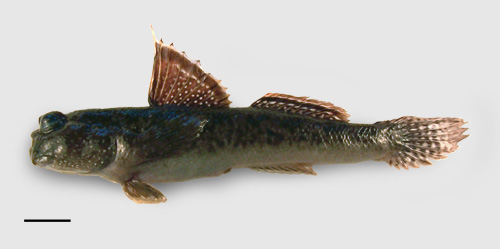
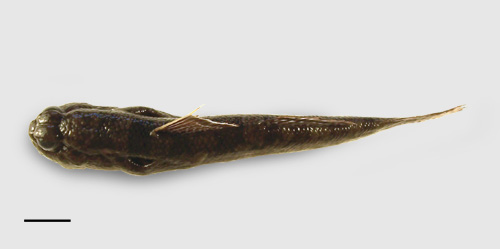
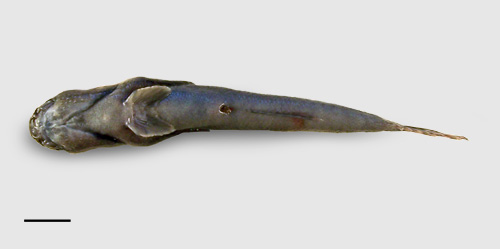
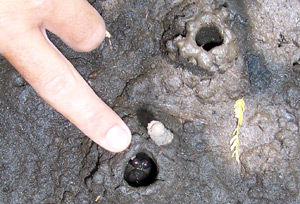
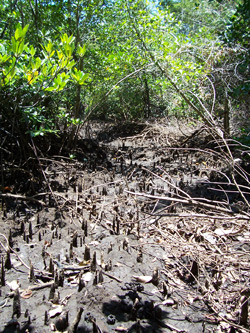
![]()